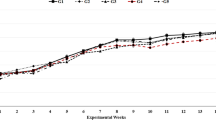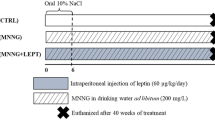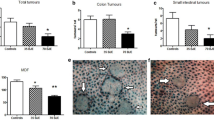Abstract
Quercetin, a flavonoid, widely distributed in many fruits and vegetables, is well known to have an antitumor effect despite its mutagenicity. In this study, we examined the effect of dietary quercetin on duodenum-tumorigenicity of mice induced by a chemical carcinogen, N-ethyl-N′-nitro-N-nitrosoguanidine (ENNG). Eight-week-old male C57BL/6 mice were divided into 4 groups; ENNG without quercetin (group A), ENNG with 0.2% quercetin (group B), ENNG with 2% quercetin (group C), and 2% quercetin without ENNG (group D). ENNG was given in drinking water for the first 4 weeks, and thereafter quercetin was given in a mixed diet. At week 20, the average number of duodenal tumors per mouse was significantly higher in group C (mean±SE, 7.26±1.75, p<0.05) than in group A (2.32±0.31). The size of the duodenal tumors increased significantly in group B (1.79±0.09 mm, p<0.001) compared with group A (1.43±0.09 mm). In contrast, no duodenal tumor was induced in group D. The present findings suggest that excessive intake of quercetin occasionally is a risk factor for carcinogenesis of some specific organs such as the upper intestine.
Similar content being viewed by others
References
Hacnszel W, Kurihara M, Segi M, Lee RKC. Stomach cancer among Japanese in Hawaii. J. Natl. Cancer Inst. 1972; 49: 969–988.
Graham S, Dayal H, Swanson M, Mittelman A, Wilkinson G. Diet in the epidemiology of cancer of the colon and rectum. J. Natl. Cancer Inst. 1978; 61: 709–714.
Phillips RL. Role of life-style and dietary habits in risk of cancer among Seventh-Day Adventists. Cancer Res. 1975; 35: 3513–3522.
Brown JP. A review of the genetic effects of naturally occurring flavonoids, anthraquinones and related compounds. Mutat. Res. 1980; 75: 243–277.
Suolinna E-M, Buchsbaum RN, Racker E. The effect of flavonoids on aerobic glycolysis and growth of tumor cells. Cancer Res. 1975; 35: 1865–1872.
Markaverich BM, Roberts RR, Alejandro MA, Johnson GA, Middleditch BS, Clark JH. Bioflavonoid interaction with rat uterine type II binding sites and cell growth inhibition. J. Steroid Biochem. 1988; 30: 71–78.
Yoshida M, Sakai T, Hosokawa N, Marui N, Matsumoto K, Fujioka A, Nishino H, Aoike A. The effect of quercetin on cell cycle progression and growth of human gastric cancer cells. FEBS Lett. 1990; 260: 10–13.
Hosokawa N, Hosokawa Y, Sakai T, Yoshida M, Marui N, Nishino H, Kawai K, Aoike A. Inhibitory effect of quercetin on the synthesis of a possibly cell-cycle-related 17-kDa protein, in human colon cancer cells. Int. J. Cancer 1990; 45: 1119–1124.
Ranelletti FO, Ricci R, Larocca LM, Maggiano N, Capelli A, Scambia G, Benedetti-Panici P, Mancuso S, Rumi C, Piantelli M. Growth-inhibitory effect of quercetin and presence of type-II estrogen-binding sites in human colon-cancer cell lines and primary colorectal tumors. Int. J. Cancer 1992; 50: 486–492.
Matsukawa Y, Nishino H, Okuyama Y, Matsui T, Matsumoto T, Matsumura S, Shimizu Y, Sowa Y, Sakai T. Effects of quercetin and/or restraint stress on formation of aberrant crypt foci induced by azoxymethane in rat colons. Oncology 1997; 54: 118–121.
Verma AK, Johnson JA, Gould MN, Tanner MA. Inhibition of 7,12-dimethylbenz(a)anthracene- andN-nitrosomethylurea-induced rat mammary cancer by dietary flavonol quercetin. Cancer Res. 1988; 48: 5754–5758.
Nishino H, Iwashima A, Fujiki H, Sugimura T. Inhibition by quercetin of the promoting effect of teleocidin on skin papilloma formation in mice initiated with 7,12-dimethylbenz(a)anthracene. Gann 1984; 75: 113–116.
Kato R, Nakadate T, Yamamoto S, Sugimura T. Inhibition of 12-O-tetradecanoylphorbol-13-acetate-induced tumor promotion and ornithine decarboxylase activity by quercetin: possible involvement of lipoxygenase inhibition. Carcinogenesis 1983; 4: 1301–1305.
Ambrose AM, Robbins DJ, DeEds F. Comparative toxicities of quercetin and quercitrin. J. Am. Pharm. Associ. Sci. Ed. 1952; 41: 119–122.
Bjeldanes LF, Chang GW. Mutagenic activity of quercetin and related compounds. Science 1977; 197: 577–578.
Carver JH, Carrano AV, MacGregor JT. Genetic effects of the flavonols quercetin, kaempferol, and galangin on Chinese hamster ovary cells in vitro. Mutat. Res. 1983; 113: 45–60.
Pamukcu AM, Yalciner S, Hatcher JF, Bryan GT. Quercetin, a rat intestinal and bladder carcinogen present in bracken fern (Pteridium aquilinum). Cancer Res. 1980; 40: 3468–3472.
Hirono I, Ueno I, Hosaka S, Takanashi H, Matsushima T, Sugimura T, Natori S. Carcinogenicity examination of quercetin and rutin in ACI rats. Cancer Lett. 1981; 13: 15–21.
Ito N, Hagiwara A, Tamano S, Kagawa M, Shibata M, Kurata Y, Fukushima S. Lack of carcinogenicity of quercetin in F344/DuCrj rats. Jpn. J. Cancer Res. 1989; 80: 317–325.
Sugimura T, Fujimura S, Baba T. Tumor production in the glandular stomach and alimentary tract of the rat byN-methyl-N′-nitro-N-nitrosoguanidine. Cancer Res. 1970; 30: 455–465.
Matsuyama M, Nakamura T, Suzuki H, Nagayo T. Morphogenesis of duodenal adenocarcinomas induced by N-ethyl-N′-nitro-N-nitrosoguanidine in mice and rats. Gann Monogr. Cancer Res. 1975; 17: 269–281.
Sunagawa M, Takeshita K, Nakajima A, Ochi K, Habu H, Endo M. Duration of ENNG administration and its effect on histological differentiation of experimental gastric cancer. Br. J. Cancer 1985; 52: 771–779.
Ohgaki H, Hasegawa H, Kusama K, Morino K, Matsukura N, Sato S, Maruyama K, Sugimura T. Induction of gastric carcinomas in nonhuman primates byN-ethyl-N′-nitro-N-nitrosoguanidine. J. Natl. Cancer Inst. 1986; 77: 179–186.
Nakamura T, Matsuyama M, Kishimoto H. Tumors of the esophagus and duodenum induced in mice by oral administration ofN-ethyl-N′-nitro-N-nitrosoguanidine. J. Natl. Cancer Inst. 1974; 52: 519–522.
Kuhnau J. The flavonoids. A class of semi-essential food components: their role in human nutrition. World Rev. Nutr. Diet 1976; 24: 117–191.
Hertog MGL, Hollman PCH, van de Putte B. Content of potentially anticarcinogenic flavonoids of tea infusions, wines, and fruit juices. J. Agric. Food. Chem. 1993; 41: 1242–1246.
Ueno I, Nakano N, Hirono I. Metabolic fate of [14C] quercetin in the ACI rat. Jap. J. Exp. Med. 1983; 53: 41–50.
Jones E, Hughes RE. Quercetin, flavonoids and the life-span of mice. Exp. Gerontol. 1982; 17: 213–217.
Yoshimoto T, Furukawa M, Yamamoto S, Horie T, Watanabe-Kohno S. Flavonoids: potent inhibitors of arachidonate 5-lipoxygenase. Biochem. Biophys. Res. Commun. 1983; 116: 612–618.
Alcaraz MJ, Hoult JRS. Actions of flavonoids and the novel anti-inflammatory flavone, hypolaetin-8-glucoside, on prostaglandin biosynthesis and inactivation. Biochem. Pharmacol. 1985; 34: 2477–2482.
Chang TH, Lee YC, Lee KY, Sun CH, Chang YP. Cocarcinogenic action of aspirin on gastric tumors induced byN-nitroso-N-methylnitroguanidine in rats. J. Natl. Cancer Inst. 1983; 70: 1067–1075.
Kort WJ, Hulsman LOM, van Schalkwijk WP, Weijma IM, Zondervan PE, Westbroek DL. Reductive effect of aspirin treatment on primary tumor growth and metastasis of implanted fibrosarcoma in rats. J. Natl. Cancer Inst. 1986; 76: 711–720.
Reddy BS, Rao CV, Rivenson A, Kelloff G. Inhibitory effect of aspirin on azoxymethane-induced colon carcinogenesis in F334 rats. Carcinogenesis 1993; 14: 1493–1497.
de la Lastra CA, Martin MJ, Motilva V. Antiulcer and gastroprotective effects of quercetin: a gross and histologic study. Pharmacol. 1994; 48: 56–62.
Mohn GR, van Zeeland AA. Quantitative comparative mutagenesis in bacteria, mammalian cells, and animal-mediated assays. A convenient way of estimating genotoxic activity in vivo? Mutat. Res. 1985; 150: 159–175.
Ogawa S, Hirayama T, Nohara M, Tokuda M, Hirai K, Fukui S. The effect of quercetin on the mutagenicity of 2-acetylaminofluorene and benzo[alpha]pyrene in Salmonella typhimurium strains. Mutat. Res. 1985; 142: 103–107.
Author information
Authors and Affiliations
Additional information
This work was supported in part by a SRF Grant for Biomedical Research (T.S.).
Rights and permissions
About this article
Cite this article
Matsukawa, Y., Nishino, H., Yoshida, M. et al. Quercetin enhances tumorigenicity induced by N-ethyl-N′-nitro-N-nitrosoguanidine in the duodenum of mice. Environ Health Prev Med 6, 235–239 (2002). https://doi.org/10.1007/BF02897975
Received:
Accepted:
Issue Date:
DOI: https://doi.org/10.1007/BF02897975




